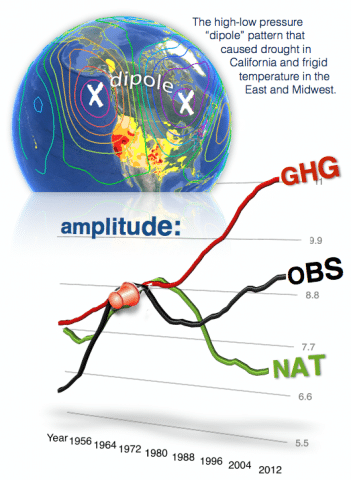A study published by Geophysical Research Letters sheds new light on the connection between California’s epic drought and human-induced climate change.
The study carries the decidedly wonky title, “Probable causes of the abnormal ridge accompanying the 2013-14 California drought: ENSO precursor and anthropogenic warming footprint.”
A subscription is required to read the full thing, but you can read the abstract, which concludes that “there is a traceable anthropogenic warming footprint in the enormous intensity of the anomalous ridge during winter 2013-14, the associated drought and its intensity.”
As the accompanying news release makes clear, this new research not only helps explain how global warming has intensified the drought in the Golden State, but also its role in the record-breaking cold weather that has hit the East Coast. But it’s the climate-drought connection that is under the most scrutiny.
Essentially, an “anomalous high-amplitude ridge system,” or a ridge of exceptionally high atmospheric pressure, has contributed to what’s known as a “dipole” — in this case, the two poles of the dipole being the high pressure in the Western U.S. and the low pressure in the East.
The researchers, from Utah State University, have “uncovered evidence that can trace the amplification of the dipole to human influences.” They go on to state that “it is important to note that the dipole is projected to intensify, which means more extreme future droughts for California.”
Not everyone accepts the connection between manmade climate change and the Cali drought. To wit, this study is likely to provoke another round in the very public debate between University of Colorado political scientist Roger Pielke, Jr. and Obama Administration Science Advisor Dr. John Holdren.
Holdren took the extraordinary step of penning a 6-page rebuttal of testimony Pielke provided to the Senate Committee on Environment and Public Works to the effect that there was no connection between climate change and droughts like the one going on in California.
Andy Revkin, the New York Times blogger at DotEarth, has also come down on the “this drought is a natural occurence” camp, recently penning a blog post in which he quoted climate scientist Martin Hoerling as saying “to state the obvious, this drought has occurred principally due to a lack of rains, not principally due to warmer temperatures.”
But this new study does not support that conclusion. It will be interesting to see how Revkin and Pielke respond.
Subscribe to our newsletter
Stay up to date with DeSmog news and alerts






